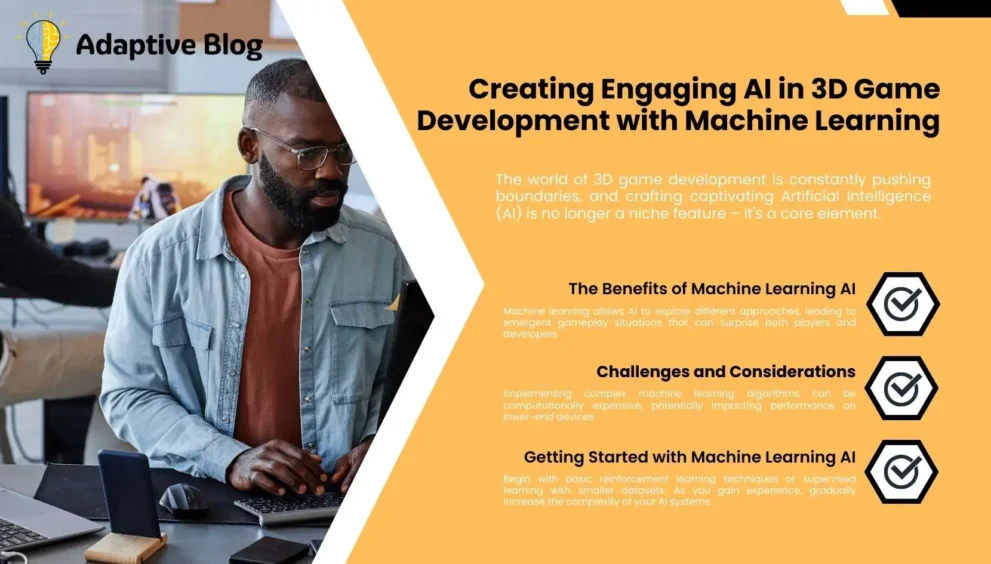Creating Engaging AI in 3D Game Development with Machine Learning

The world of 3D game development is constantly pushing boundaries, and crafting captivating Artificial Intelligence (AI) is no longer a niche feature – it’s a core element. AI breathes life into your game world, populating it with believable enemies, dynamic companions, and immersive challenges that test players’ skills. But crafting truly engaging AI goes beyond simple pathfinding and pre-programmed behaviors. It’s about creating intelligent entities that react realistically to the environment and player actions and even learn and adapt over time. Here’s where the power of machine learning comes into play, taking 3D game development to a whole new level.
Traditional AI vs. Machine Learning AI: Understanding the Difference
Traditionally, 3D game developers rely on behaviour trees. These are pre-defined sets of rules that govern an AI entity’s actions. For example, a basic enemy AI might have a behavior tree that dictates it patrols a specific area attacks the player on sight, and flees if it takes too much damage. While effective for simpler scenarios, these approaches can lead to predictable and repetitive AI behaviours. Players can quickly learn to exploit these patterns, making the AI feel less than intelligent.
Machine learning, on the other hand, empowers you to create AI that can learn and adapt over time. This can be achieved through various techniques, including:
Reinforcement Learning: Imagine setting up a reward system for your AI. Through trial and error, the AI learns which actions lead to desired rewards (e.g., defeating the player) and adjusts its strategy accordingly. Picture an enemy AI that starts off charging the player head-on but learns to take cover after several failed attempts.
Supervised Learning: Here, you provide the AI with a massive amount of labelled data, such as examples of successful and unsuccessful gameplay for enemies. Imagine feeding your AI footage of human players defeating enemies and footage of enemies winning encounters. The AI analyzes this data and learns to identify patterns, ultimately making better decisions within the game environment.
The Benefits of Machine Learning AI
Why should you consider incorporating machine learning into your 3D game development workflow? Here are some compelling reasons:
Emergent Gameplay: Machine learning allows AI to explore different approaches, leading to emergent gameplay situations that can surprise both players and developers. Imagine an enemy AI that learns to flank the player based on past encounters, creating a more dynamic and unpredictable experience.
Increased Realism: Imagine enemy AI that reacts and adapts dynamically to player actions and environmental changes. This creates a more believable and immersive experience for players. Picture enemies taking cover under fire, retreating to heal, or even coordinating attacks with other AI entities – all learned through machine learning.
AI Customization: Developers can tailor the learning process for AI entities, creating a wider variety of AI behaviors within the game. Imagine having enemy AI specialising in ranged attacks while others excel in close combat, all learned through carefully designed machine learning algorithms.
Challenges and Considerations
While machine learning offers exciting possibilities, it also comes with challenges that developers need to be aware of:
Computational Cost: Implementing complex machine learning algorithms can be computationally expensive, potentially impacting performance on lower-end devices. You’ll need to carefully optimize your AI systems to ensure a smooth gameplay experience for all players.
Data Requirements: Effective machine learning often requires vast amounts of labeled data for the AI to train on. Gathering and preparing this data can be a time-consuming process. Depending on the complexity of your AI, you might need to invest significant resources in data acquisition and management.
Development Expertise: Integrating machine learning techniques requires additional knowledge and expertise compared to traditional AI scripting. You might need to consider hiring developers with a background in machine learning or upskilling your existing team to implement this technology successfully.
Getting Started with Machine Learning AI
For 3D game developers interested in incorporating machine learning into their projects, here are some practical steps to get you started 3D game development:
Start Simple: Begin with basic reinforcement learning techniques or supervised learning with smaller datasets. As you gain experience, gradually increase the complexity of your AI systems. Don’t try to build a super-intelligent AI right off the bat – start small, learn the ropes, and iterate as you go.
Utilize Available Tools: Several frameworks and libraries can simplify the integration of machine learning into your 3D game development projects. Explore options like TensorFlow or PyTorch, which offer user-friendly tools for building and training machine learning models. These tools can significantly lower the barrier to entry for developers who might not have extensive machine-learning experience.
Focus on Player Experience: Remember, the ultimate goal is to create engaging gameplay. Use machine learning to enhance AI behavior in a fun and challenging way for players, not just create artificially intelligent opponents.
Examples of Machine Learning AI in Action
Machine learning isn’t just theoretical – it’s already being used to create engaging AI experiences in some of the most popular 3D games:
Dota 2 (Valve): The complex AI opponents in Dota 2, known as “bots,” utilize machine learning to constantly learn and adapt. These bots analyze past encounters with human players and adjust their strategies accordingly, making them formidable opponents who provide a continuous challenge.
Spore (Electronic Arts): The AI creatures in Spore evolve through a process of reinforcement learning. As players interact with these creatures and influence their environment, the creatures learn and adapt their behavior, creating a dynamic and ever-changing world.
Sid Meier’s Civilization VI (Firaxis Games): The AI leaders in this strategy game are powered by machine learning. These leaders learn player tendencies and adjust their diplomatic and military strategies accordingly. Imagine facing an AI opponent who knows you prefer a peaceful approach and tailoring their strategy to exploit that, forcing you to adapt your tactics.
These are just a few examples, and the possibilities are truly endless. As machine learning technology evolves, we can expect even more sophisticated AI experiences in 3D game development.
The Future of Machine Learning AI in 3D Game Development
The future of AI in 3D game development powered by machine learning is brimming with exciting possibilities:
AI Companions: Imagine AI companions that learn your playstyle and adapt their strategies to complement yours. Picture a stealthy AI companion that flanks enemies while you create distractions or a powerful companion that draws enemy fire while you unleash your ultimate attack.
Dynamic Battlefields: Imagine vast battlefields where AI factions wage war, constantly evolving their tactics based on victories and defeats. Machine learning could create truly epic and unpredictable battles that feel fresh every time you play.
Procedural Storytelling: Imagine narratives that unfold differently based on player choices and AI behavior influenced by machine learning. This could create a more personalized and immersive storytelling experience for players.
The potential for machine learning in 3D game development is vast, and the future holds incredible possibilities for creating groundbreaking AI experiences. So, are you ready to take your 3D game development projects to the next level and craft AI that leaves players awestruck? With careful planning, the right tools, and a focus on creating engaging gameplay, machine learning can be the key to unlocking a new era of intelligent and dynamic AI in your games.
Also Read: OKR Writing Tips: Transforming Ambition into Actionable Goals
Conclusion
While machine learning offers exciting opportunities, it’s not a magic bullet. Remember, it’s a powerful tool that requires thoughtful implementation. Carefully consider your project’s needs, resource limitations, and target audience before diving in. Start small, experiment strategically, and prioritize creating an enjoyable player experience.
By embracing the potential of machine learning and approaching it with a thoughtful and creative mindset, you can elevate your 3D game development projects to new heights. So, are you ready to embark on this exciting journey and craft AI that truly redefines the player experience?
The world of 3D game development awaits, and with machine learning as your ally, the possibilities are limitless. Now, go forth and create something truly remarkable!





